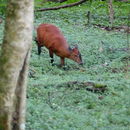Biology
provided by Arkive
Like other duikers, (a word meaning 'diver' in Dutch) (4), the Natal duiker is a shy animal that dives for forest cover at the slightest disturbance (3). Generally the Natal duiker is seen on its own, but occasionally a pair or a female with her offspring may be observed. When Natal duikers do meet, they greet each other by rubbing their facial scent glands together; these scent glands are also used to mark branches, twigs and tree trunks within their range. Only occasionally may a meeting between duikers escalate in to a fight, when the small, sharp horns can be used to inflict considerable wounds (3).
Natal duikers consume a diet of flowers, foliage and fruit that has recently fallen from trees (2) (3). Often, this duiker has been seen under trees where a troop of monkeys are feeding, taking advantage of the plentiful, carelessly dropped fruit (3). While in most areas, foraging for this food is undertaken during daylight hours, in highly disturbed areas the Natal duiker may become nocturnal (2). Females give birth to a single lamb after a gestation of about 210 days (3).
Conservation
provided by Arkive
The Natal duiker occurs in a number of protected areas, including the Greater St Lucia Wetland Park, South Africa and Kilimanjaro National Park, Tanzania; both Natural World Heritage Sites (6) (7). In some areas in southern Africa, the Natal duiker has been reintroduced to some of its former range (3). Otherwise, there are no specific conservation measures known to be in place for this duiker. The threats it faces, bushmeat hunting and habitat loss, are complex issues that need to be addressed with a diversity of approaches if the numerous species affected are to survive.
Description
provided by Arkive
This small, stocky antelope has an attractive chestnut-red coat that can, surprisingly, obscure its appearance in the dappled light of the forest. Both male and female Natal duikers have short, straight, backward-sloping horns, hidden amongst a tuft of long and bushy chestnut-black hair (3). The margins of the ears, chin, throat and underside of the tail are white, while the upperside of the tail, ears and muzzle are black (2). The neck turns blue-grey with age and in front of the eyes sits conspicuous long, thin scent glands (3).
Habitat
provided by Arkive
The Natal duiker inhabits coastal forests, montane forests and dense thickets. It appears that a wide range of trees that flower and fruit throughout the year are essential features of the duiker's habitat (2).
Range
provided by Arkive
Occurs in indigenous forest along the eastern coast of Africa; in Malawi, Mozambique, South Africa, Swaziland, Tanzania and Zambia (1) (3).
Status
provided by Arkive
Classified as Least Concern (LC) on the IUCN Red List (1).
Threats
provided by Arkive
The Natal duiker is the subject of intensive hunting and trapping for the bushmeat trade over much of its range (2); in Tanzanian forests it is one of the most frequently hunted species (5). In addition, the exploitation of extensive areas of forest throughout its range for commercial forestry, settlement and agriculture, has reduced the amount of suitable habitat available for the Natal duiker (2) (3). While this little antelope remains widespread, and is common in many areas (2), these threats have caused its disappearance from some areas, such as the coastal areas of South Africa, south of Durban (3).

